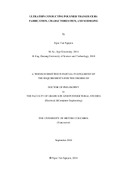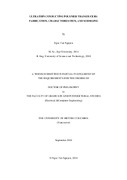
Vui lòng dùng định danh này để trích dẫn hoặc liên kết đến tài liệu này:
http://thuvienso.dut.udn.vn/handle/DUT/1927| Trường DC | Giá trị | Ngôn ngữ |
|---|---|---|
| dc.contributor.author | Nguyen, Ngoc Tan | |
| dc.date.accessioned | 2024-11-06T01:45:21Z | - |
| dc.date.available | 2024-11-06T01:45:21Z | - |
| dc.date.issued | 2018 | |
| dc.identifier.uri | http://thuvienso.dut.udn.vn/handle/DUT/1927 | - |
| dc.description | Doctoral thesis. Major: Electrical and computer engineering; 182 pages | vi |
| dc.description.abstract | Recently, ultrathin poly (3,4-ethylenedioxythiophene) (PEDOT) – based ionic actuators have overcome some initial obstacles to increase the potential for applications in microfabricated devices. While microfabrication processing of trilayer actuators that involve no manual handling has been demonstrated, their mechanical performances remain limited for practical applications. The goal of this thesis is to optimize the transducers in thin films fabrication by micro technologies, fully characterize the electrochemomechanical properties of the resulting trilayers, and develop a model to simulate their bidirectional electromechanical ability (actuation and sensing). At first, ultrathin PEDOT-based trilayer actuators are fabricated via the vapor phase polymerization of 3,4-ethylenedioxythiophene combining with the layer by layer synthesis process. This constitutes the first full characterization of ionic PEDOT-based microactuators operating in air of such a small thickness (17 µm) having bending deformation and output force generation of 1% and 12 µN respectively. Secondly, electrical, electrochemical and mechanical properties of the resulting microactuators have been thoroughly studied. Non-linear characterization was extended to volumetric capacitance dependence on voltage window. Damping coefficient was characterized for the first time. Thirdly, a nonlinear multi-physics model was proposed as a method of simulating actuator and sensor responses in trilayers, represented using a Bond Graph formalism, and was able to implement all of the characterized parameters. The concordance between the simulations and the measurements confirmed the accuracy of the model in predicting the non-linear dynamic electrochemical and mechanical response of the actuators. In addition, the information extracted from the model also provided an insight into the critical parameters of the actuators and how they affect the actuator efficiency, as well as the energy distribution. These are the key parameters for designing, optimizing, and controlling the actuation behavior of a trilayer actuator. Finally, a nouveau bidirectional electromechanical linear model was introduced to simulate the sensing ability of the trilayer transducer. The simulation coherently matches the experimental results in both frequency and time domains of a sinusoidal input displacement. The resulting actuators and the proposed models are promising for designing, optimizing, and controlling of the future soft microsystem devices where the use of polymer actuators should be essential. | vi |
| dc.language.iso | en | vi |
| dc.publisher | L’UNIVERSITÉ DE POLYTECHNIQUE DES HAUTS-DE-FRANCE ET L’UNIVERSITÉ DE COLOMBIE BRITANNIQUE | vi |
| dc.subject | Electroactive polymer | vi |
| dc.subject | Conducting polymer transducers | vi |
| dc.subject | Interpenetrating networks | vi |
| dc.subject | Non-linear characterization | vi |
| dc.subject | Non-linear dynamic modeling | vi |
| dc.subject | Bond Graph formalism. | vi |
| dc.title | Ultrathin conducting polymer transducers: Fabrication, characterization, and modeling | vi |
| dc.type | Luận án | vi |
| item.fulltext | Có toàn văn | - |
| item.cerifentitytype | Publications | - |
| item.openairecristype | http://purl.org/coar/resource_type/c_18cf | - |
| item.openairetype | Luận án | - |
| item.grantfulltext | restricted | - |
| item.languageiso639-1 | en | - |
| Bộ sưu tập: | Khoa Điện - LA Ngành Kỹ thuật Điện | |
Các tập tin trong tài liệu này:
| Tập tin | Mô tả | Kích thước | Định dạng | Đã có tài khoản, vui lòng Đăng nhập |
|---|---|---|---|---|
| NguyenNgocTan.TT.pdf | Abstracts & Table of Contents | 1 MB | Adobe PDF |  |
| NguyenNgocTan.TV.PDF | Fulltext | 13.04 MB | Adobe PDF |  |
Các đề xuất từ CORE
Lượt xem 20
48
đã cập nhật vào 15-11-2025
Lượt tải xuống 50
17
đã cập nhật vào 15-11-2025
Google Scholar TM
Kiểm tra...
Khi sử dụng các tài liệu trong Hệ thống quản lý thông tin nghiên cứu phải tuân thủ Luật bản quyền.